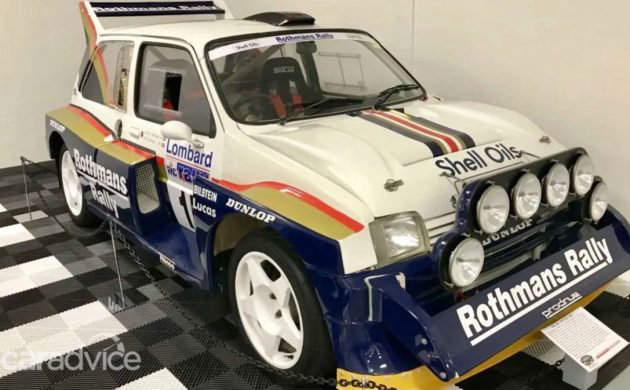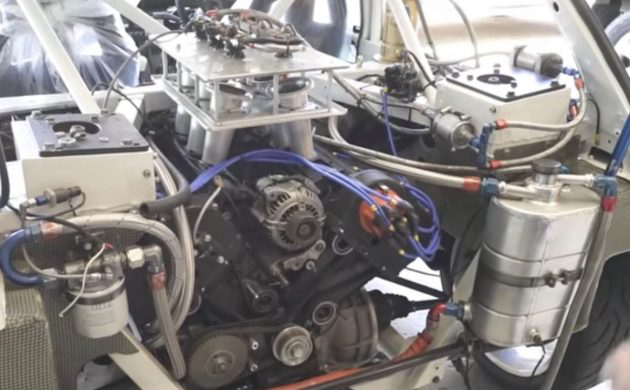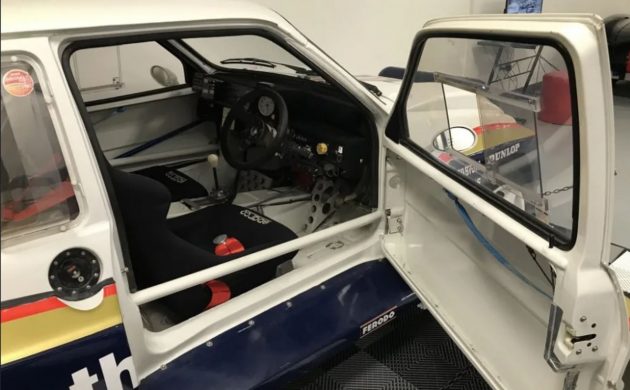Genuine Group B: 1985 MG Metro 6R4 WRC
The Group B era of the World Rally Championship was one marked by an “arms race” between several manufacturers. Introduced in 1982, it saw some motoring monsters built by the likes of Audi, Lancia, Ford, and MG. The category was disbanded in 1986 as the cars were, by that stage, deemed to be too fast and too dangerous. This 1985 MG Metro 6R4 is relatively typical of the Group B vehicles of the day, featuring enormous engine power and full-time 4-wheel-drive. It has been faithfully restored and is set to go to a new home. The Metro is located in Launceston, Tasmania, Australia, and has been listed for sale here at Pickles Auctions. There is no indication of just where the reserve has been set, but when you visit the website, the opening bid has been default set at $200,000.
For me, this Metro is an exciting proposition. This is because I have had the opportunity to inspect the car in person when visiting the National Automobile Museum of Tasmania in Launceston. The vehicle presents exceptionally well, but there have been no attempts made to represent it in any way other than as a full-blown international rally car. That means that while the panels and paint are in beautiful condition, the car features all of the usual rough edges of a vehicle that was deemed to be “disposable.” The simple fact was that every time that these vehicles saw competition use, they had anything but an easy life. The going was rough, with the paint and panels baring the brunt of rock and stone damage. There was also a reasonable chance that they could find themselves shiny-side down or disappearing into the scenery at some point. That meant that not a lot of time or effort was spent smoothing out some of the rough edges from construction. The 6R4 benefited from a significant amount of engineering input from Williams Grand Prix, which was beginning to become a real force in Formula 1 competition. They had received sponsorship from Leyland and had secured the 1980 World Championship with Aussie Alan Jones. That made the company a natural choice to assist MG to achieve their WRC ambitions. The method of engineering and constructing a 6R4 was interesting because all of the roll cage and infrastructure were hand-fabricated. Then the main body-shell structure was literally welded over the top of the roll cage. When you look around the inside of the door frames and the A-Pillars, this type of work is very apparent. Almost all of the bolt-on panels are made from either fiberglass or composite materials, which was more robust than steel, and was significantly lighter. Enormous amounts of power are of no use if they can’t be put to the ground effectively. Therefore, the spoilers that are attached to this car aren’t merely there for looks. They provide measurable levels of downforce at both the front and the rear of the Metro to improve grip. Plenty of grip is always a nice thing when you are screaming along a dirt rally stage at better than 100mph.
If you wandered into your local MG showroom to purchase a Metro back in the early 1980s, the best that you could hope for was a car that was equipped with a 4-cylinder turbocharged engine, producing 93hp. Those ponies were sent to the front wheels via a 5-speed manual transmission. The car would have been a respectable performer, but would never have cut the mustard in Group B competition. The 6R4 was typical of the arms race that prevailed then and was an extremely potent piece of equipment. Under the hood was filled with little more than fresh air, because the Group B Metro featured a mid-mounted 2,991cc V6. Standard operating procedures amongst front-running Group B manufacturers was to follow the turbocharged route, but MG marched to the beat of a different drummer. Turbocharged engines of the early 1980s tended to suffer from horrendous levels of turbo lag, along with heat dissipation and reliability issues. The decision was made to adopt a purpose-built V6 that owed a lot to Formula 1 technology. As a result, it featured quad camshafts, 24 valves, fuel injection, and a dry-sump lubrication system. All of this effort resulted in an engine that pumped out 410hp in race tune, with the engine shift light set to illuminate at an incredible 13,500rpm! When you look at this photo of the engine, it seems blindingly obvious that it is mounted back-to-front. This was by design, making it easy to engineer and maintain the Metro in 4-wheel-drive form. Bolted to the engine is a 5-speed Hewland transmission, which sends the engine’s power to the front and rear Hewland differentials. With that much power and full-time 4-wheel-drive, acceleration was eye-watering. The 6R4 was capable of sprinting from 0-60mph in 3.0 seconds. The top speed was dependent on the chosen final drive ratios, but the transmission itself was interesting. The first four gears were effectively close-ratio gear-sets, while the fifth gear is exceptionally tall. This allowed plenty of flexibility in tight and twisting competition but allowed the Metro to stretch its legs on open ground. The good news here is that the MG has recently undergone a mechanical refresh, and runs and drives well. It also features the tires and suspension settings for tarmac rallying, meaning that it could conceivably be used for circuit work.
It doesn’t matter what form of motorsport you might be considering; it will always be a case of weight being the enemy. That was true in Group B competition, so the interior of the Metro is utilitarian. Beyond the body-hugging seats, there are no creature comforts. As is the case with the rest of the vehicle, the interior presents well for a rally car of this era. The driver has everything that he needs at his fingertips, including a full array of gauges, a brake balance adjuster, and a stubby and robust shifter for that Hewland transmission. Rally navigators have a tough gig and have to be masters of multi-tasking. They must read pace notes and convey this information clearly and concisely to the driver. In the 6R4, they also performed an additional duty. All of the electrical fuses and circuit breakers are located on the dash directly in front of the navigator. In the event of an electrical fault, it was the duty of the navigator to attend to these problems and to reset circuit breakers. The life of a navigator is definitely a busy one.
We will never see the likes of the Group B rally cars again because they have been deemed to be too fast for safe competition. Too many competitors and spectators lost their lives because of this fact. The death of three spectators at the 1986 Portuguese Rally did the category enormous damage. Its fate was sealed by the tragic accident that claimed the lives of Henri Toivonen and his navigator, Sergio Cresto, during the running of that year’s Tour de Corse. On December 31st, 1986, Group B competition was no more. Therefore, someone is set to become the new owner of a unique piece of motorsport history.
Auctions Ending Soon
 2002 Subaru Impreza WRXBid Now2 days$333
2002 Subaru Impreza WRXBid Now2 days$333
 1975 Chevrolet Corvette ConvertibleBid Now2 days$4,000
1975 Chevrolet Corvette ConvertibleBid Now2 days$4,000
 1964 Ford F-100 Camper CustomBid Now2 days$2,000
1964 Ford F-100 Camper CustomBid Now2 days$2,000
 2006 Jeep Wrangler SportBid Now4 days$10,500
2006 Jeep Wrangler SportBid Now4 days$10,500
 1974 Datsun 260ZBid Now6 days$200
1974 Datsun 260ZBid Now6 days$200






Comments
As is said in New England, they were “wicked” fast. Would love to have one but I don’t have $200,000 to start the bidding.
We were in Monte Carlo coincidentally at the same time as the 1984 Rally Monte-Carlo. We went to see some of the ‘action’ and ‘action’ is the world’s largest understatement. The first car that passed us (completely and totally out of control it seemed!!) was an RS200 and it made my heart swell for being a Ford dealer. Thought about importing one but there was no way whatsoever. Those Group B cars could only be described as INSANE. This piece is awesome!!
A friend had one of these, smuggled out of the factory after it closed down, but he fitted a Rover / Buick V8 for reliability and entered the Paris Dakar rally in it, he broke down on the second day and called me to see if I could get a set of shocks out to the desert using my Cessna 172, I told him it was a nice thought but it would take me something like 3 days to get there (from just north of London UK) and probably a couple of days to plan it first, shame would have been the highlight of my flying days!
I think all the Metro turbo’s had a 4 speed box, 5 speed came with the Rover Metro and K series engine.
I think that the price is $AUS so $200kAUS = $140K USD – which is quite fair for a group B rally car – if you have a big enough back yard to run it! Retrogreg
Around the late ’80’s, one of these was sitting in the – at that time, very small BMW dealer showroom by itself, on E. Colonial Dr. in Orlando. Solid white and looked new. I was told they wanted around $35K for it. Of course, I was broke, but 4 yrs. later, could have written a check for it. I also remember a BMW M1 there too.
The STD metro Inc the turbo had a 4 speed box, the same transverse ASeries ( with minor mods to the cooling system) engine & gearbox as used since 1959 in mini’s & 1100/1300 variants ( Austin America etc), Allegro etc.
The group B cars where insane ( no other word for it) the remainder of the 6R4 engines ( after they were banned) were used up in the jaguar XJ220 super cars!
It’s said that most of the group B cars could accelerate fast from 0-60 than if they were dropped vertically.
I remember passing through a sleepy little Lincolnshire village one Friday evening in the early 90’s & coming across one of the few road going Ford RS200’s just parked by the roadside it looked like a spaceship compared to all the mundane stuff on the roads at that time.
After Group B finished, BL struggled to sell their remaining stock of 6R4s. They ended up being sold off at a loss; £25k or something like that.
Oh my.
If this is on Pickles Auctions, I wonder if I can get a great “dill”